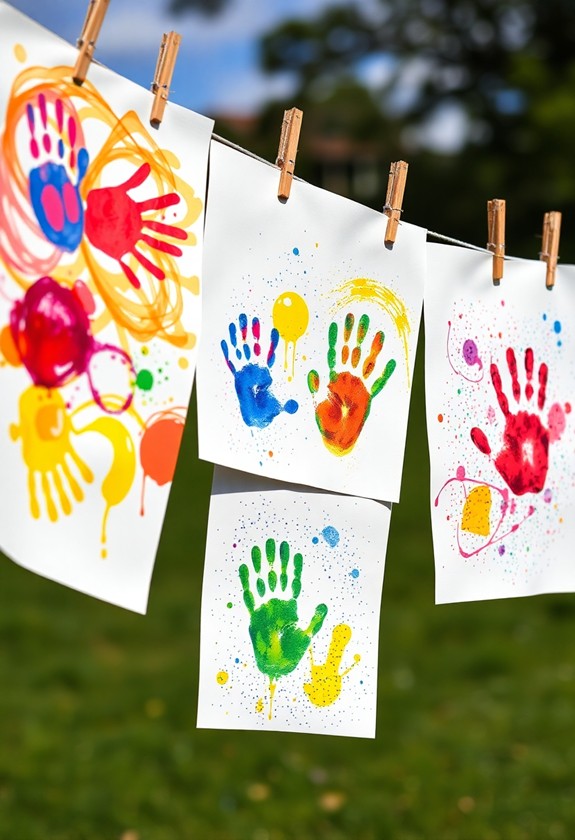Art isn't just messy fun for your toddler – it's a brain-boosting bonanza! Through colorful creativity, your little one develops fine motor skills and hand-eye coordination. They'll investigate textures, sounds, and smells, stimulating their senses. Watch their imagination soar as they dream up masterpieces! Art time is additionally prime time for language development and problem-solving practice. It's an emotional outlet too, helping kiddos express themselves. Plus, they'll sharpen visual-spatial skills and learn to focus like mini Picassos! From squiggles to sculptures, each artistic adventure is packed with learning potential. Ready to release your toddler's inner artist? There's so much more to uncover!
Creative Highlights
- Art enhances fine motor skills and hand-eye coordination through activities like drawing, cutting, and molding.
- Creative activities stimulate sensory processing by engaging touch, sight, sound, and smell.
- Artistic expression fosters creativity, imagination, and problem-solving abilities in toddlers.
- Art activities boost language development by expanding vocabulary and encouraging descriptive communication.
- Engaging in art promotes emotional expression and helps develop emotional intelligence in young children.
Enhances Fine Motor Skills
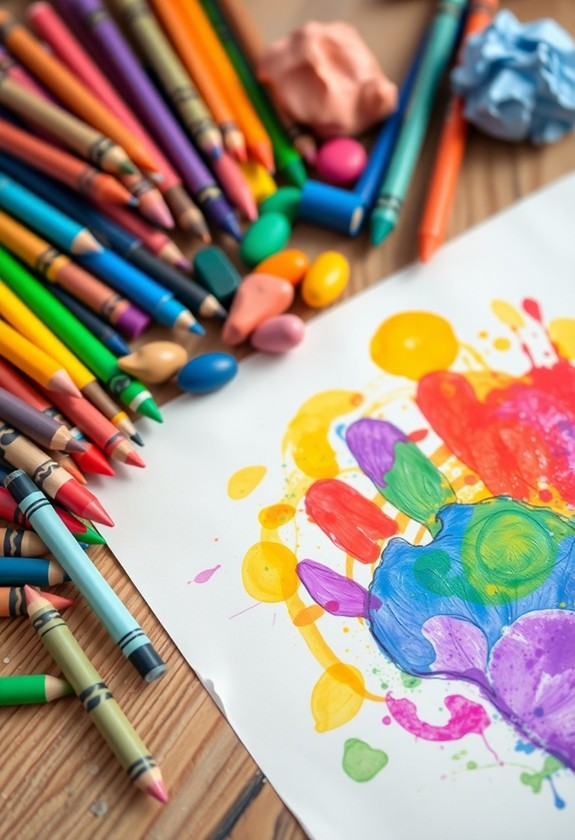
Numerous art activities help toddlers develop their fine motor skills. When your little one grabs a crayon or paintbrush, they're not just making a masterpiece—they're building essential hand-eye coordination! Every scribble, squiggle, and splat strengthens those tiny fingers and wrists. Craft kits for toddlers offer a variety of engaging projects that cater to different interests and skill levels, promoting creativity without strict guidelines. These kits can likewise provide educational value by incorporating themes like science and math.
Drawing and Painting: These classic activities are a fine motor skill bonanza! Encourage your tot to experiment with different tools. Chunky crayons, finger paints, and washable markers are perfect for beginners. As they progress, introduce smaller crayons and paintbrushes for an extra challenge.
Cutting and Pasting: Safety scissors are a game-changer! Let your budding artist cut paper into strips or shapes. Then, it's glue time! Squeezing a glue bottle requires serious muscle control. For a mess-free option, try glue sticks.
Play Dough Fun: This squishy wonder is a fine motor powerhouse! Rolling, pinching, and molding play dough works those little hand muscles. Plus, it's endlessly entertaining. Who doesn't love making mini-sculptures and imaginary cookies?
Stimulates Sensory Processing

Art activities awaken a toddler's senses, providing rich opportunities for sensory exploration. When your little one squishes play dough, splashes in finger paint, or scribbles with crayons, they're not just creating masterpieces – they're exercising their sensory superpowers! Non-toxic, washable options guarantee safe and worry-free creative experiences for your toddler. Water-based paints and markers are particularly suitable for young artists, as they're less likely to cause allergic reactions.
Touch: Feel the difference between smooth paper and bumpy cardboard. Squish, stretch, and mold clay to experience texture and resistance. Let them get messy with gooey glue or slimy slime – it's a tactile adventure!
Sight: Introduce a rainbow of colors through paints, markers, and colorful papers. Watch their eyes light up as they mix hues and create new shades. Encourage them to spot shapes and patterns in their artwork.
Sound: Crinkle tissue paper, tap on different surfaces, or shake a homemade maraca. Art can be music to their ears!
Smell: Use scented markers or add a dash of vanilla to play dough for an olfactory twist.
Taste: Although we don't eat art supplies, discussing flavors can add another dimension to their creations. "Does that yellow sun look lemony?"
Fosters Creativity and Imagination
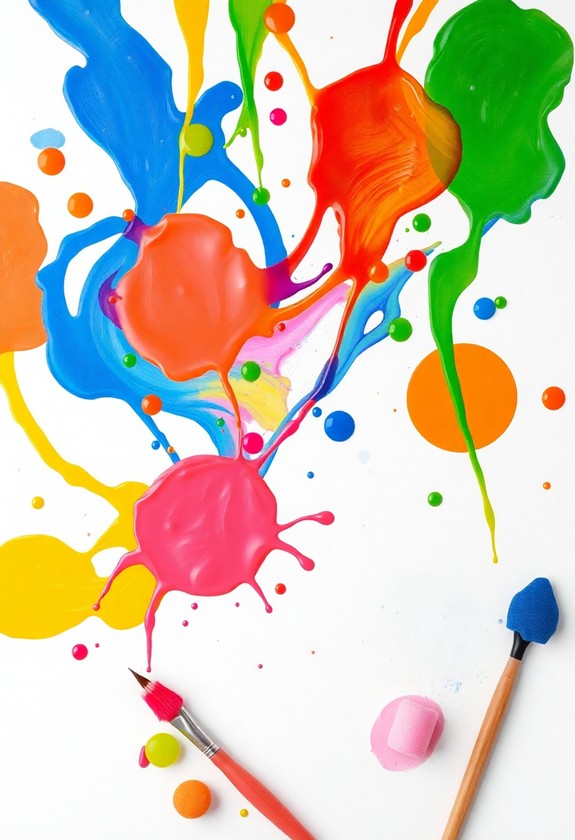
Toddler imagination-power flourishes through artistic expression. When your little one dips their fingers in paint or scribbles with crayons, they're not just making a mess – they're releasing their creativity! Art gives toddlers a magical portal to express their wildest ideas and dreams. It's like opening a treasure chest of imagination! Comprehensive art kits designed for toddlers can further improve this creative adventure, offering a variety of materials to investigate and experiment with.
Release the imagination:
- Encourage free drawing – let their minds wander!
- Provide various materials – from clay to feathers
- Ask open-ended questions about their creations
Watch as your toddler transforms a simple box into a rocket ship or a cardboard tube into a telescope. Art helps them think outside the box (pun intended)! They'll learn there's no right or wrong way to create, boosting their confidence to try new things.
Benefits of nurturing creativity:
- Improves problem-solving skills
- Boosts self-expression
- Develops unique thinking patterns
Improves Hand-Eye Coordination

Nearly every artistic activity your toddler engages in improves their hand-eye coordination. When they grasp a crayon, mold clay, or wield a paintbrush, they're fine-tuning their motor skills! It's like a workout for their little fingers and eyes, working together in perfect harmony. Arts and crafts provide numerous benefits for children, including cognitive development and stress relief. These activities likewise improve focus and concentration throughout the crafting process.
Drawing and Painting: These classic art forms are hand-eye coordination champions! Your tot's brain is working overtime to guide their hand as they create masterpieces. And don't forget about coloring inside the lines – it's a coordination challenge that's both fun and rewarding!
Cutting and Pasting: Safety scissors aren't just for making a mess! They're coordination boosters too. Cutting along lines or shapes helps your child focus and control their movements. And gluing? It's a sticky situation that requires precision and care!
Sculpting and Molding: Play-doh isn't just squishy fun – it's a hand-eye workout! Shaping, rolling, and squishing all require careful coordination. Your little Michelangelo is building skills with every squeeze!
Boosts Language Development
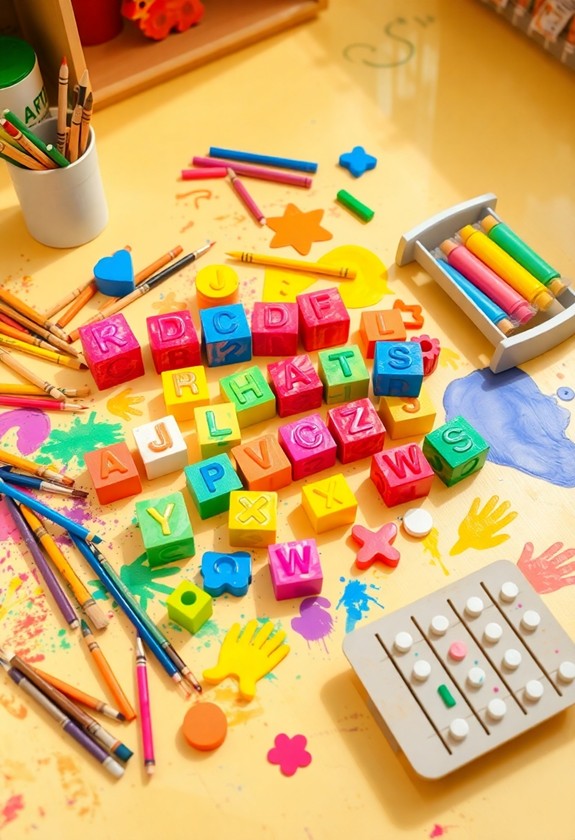
As your little one's hands are busy creating, their brain is quietly building language skills. It's like a secret superpower art gives your toddler! As they're splashing paint or molding clay, they're likewise developing their vocabulary. How cool is that?
You'll hear them chatting away about colors, shapes, and textures. "Look, Mommy! I made a blue circle!" They're not just describing their masterpiece; they're expanding their word bank! And when you join in the fun, you're giving them even more language exposure. It's a win-win! Finger painting with washable, non-toxic paints not only boosts sensory exploration but likewise promotes color recognition, further advancing vocabulary development.
Art time is likewise story time. As your little Picasso creates, they'll often narrate what they're doing. This improves their storytelling skills and sentence structure. Plus, it's adorable to hear their imaginative tales!
Don't forget to ask questions about their artwork. "What's this squiggly line?" or "Why did you choose red?" These questions encourage them to think critically and express themselves verbally. Before you know it, your tiny artist will be a chatterbox extraordinaire! So grab those crayons and let the language learning begin!
Encourages Problem-Solving Abilities
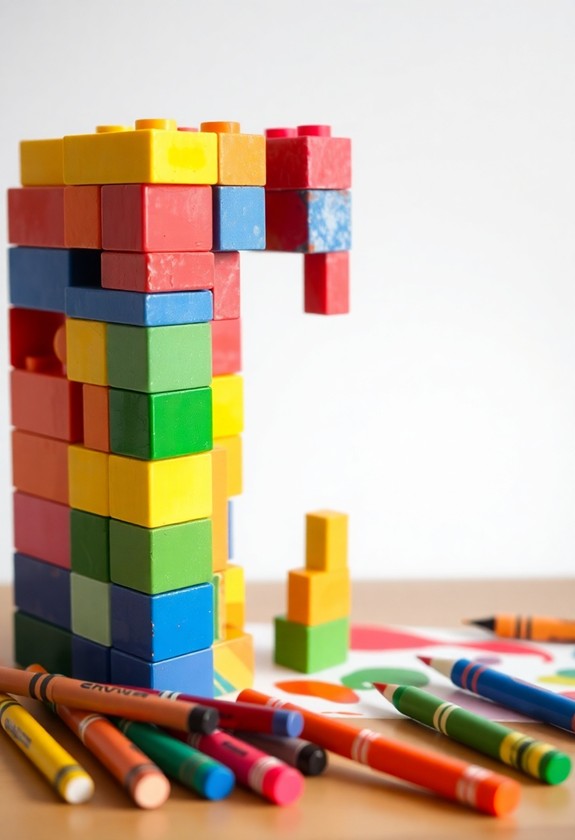
Every time your toddler picks up a crayon or paintbrush, they're not just creating art—they're solving problems. It's like a mini brain workout! When your little one decides which color to use or how to draw a shape, they're flexing their problem-solving muscles.
Art challenges kids to think creatively. They'll ask themselves: "How can I make this circle look like a sun?" or "What happens if I mix these colors?" These questions spark critical thinking! Plus, when something doesn't work out as planned, they learn to adapt and try again. That's resilience in action!
You can boost this brain-building by asking open-ended questions. "What would happen if you used a different brush?" or "How else could you make that tree?" These questions encourage your toddler to think outside the box and come up with innovative solutions.
Promotes Emotional Expression
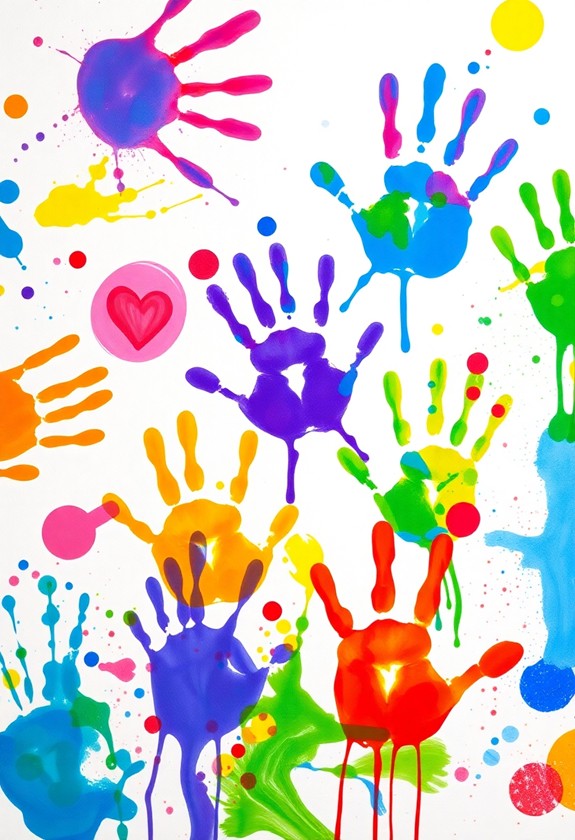
Through art, toddlers find a powerful outlet for their emotions. It's amazing how a simple crayon or paintbrush can unlock a world of feelings! Your little one might not have the words to express themselves yet, but they can definitely show you how they feel through their artwork.
Colors and Feelings: Watch as your toddler chooses colors. Bright, lively hues often indicate happiness, whereas darker shades might suggest sadness or frustration. It's like a mood ring for their masterpieces!
Scribbles and Strokes: The way your child applies paint or crayon can be telling too. Gentle, flowing lines might mean they're calm, whereas vigorous scribbling could signal excitement or anger. Talk about wearing your heart on your sleeve – or canvas!
Art as a Conversation Starter: Use their creations to chat about emotions. "Oh, that's a lot of red! Were you feeling excited?" This helps them connect their feelings to their art and builds emotional intelligence.
Develops Visual-Spatial Skills
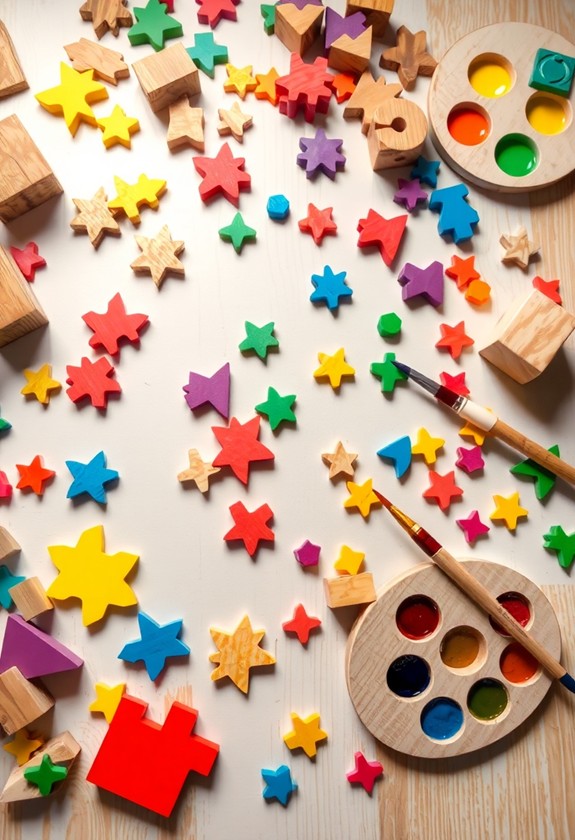
As art helps toddlers express their emotions, it is furthermore sharpening their visual-spatial skills. These skills are essential for understanding the world around them and how objects relate to each other. When your little one draws, paints, or sculpts, they're not just making pretty pictures – they're building their brain power!
How art develops visual-spatial skills:
- Shape recognition: Drawing circles, squares, and triangles helps your toddler identify and differentiate shapes in their environment.
- Size comparison: Painting objects of different sizes teaches them about proportions and relationships between objects.
- Spatial awareness: Creating 3D art, like clay sculptures, boosts their understanding of depth and space.
- Pattern recognition: Coloring or creating repeating patterns improves their ability to spot and create sequences.
- Mental rotation: Turning and manipulating objects in art activities enhances their ability to visualize objects from different angles.
Get ready to watch your little Picasso's brain grow! Encourage them to investigate different art forms and materials. Who knows? They might just become the next "Vincent van Grow"! Art isn't just fun – it's a powerful tool for developing your toddler's visual-spatial skills.
Cultivates Focus and Concentration

With art activities, toddlers naturally develop their ability to focus and concentrate. It's amazing to watch! As they immerse themselves in their colorful creations, you'll notice how they become completely absorbed in their work. This laser-like focus is an essential skill that'll serve them well throughout their lives.
How art cultivates concentration:
- Time flies when they're having fun! Art projects can keep your little one engaged for longer periods.
- They'll learn to follow step-by-step instructions, boosting their attention span.
- Repetitive actions, like coloring or painting, help build patience and persistence.
You can encourage this focus by:
- Creating a distraction-free art space
- Letting them choose their materials (options are the spice of life!)
- Praising their efforts, not just the end result
Curious Little Questions
At What Age Should I Introduce Art Activities to My Toddler?
You can start introducing art activities to your toddler as early as 12-18 months old. It's never too soon to get creative! Begin with simple, safe activities like finger painting or scribbling with chunky crayons. As they grow, introduce new materials and techniques. Remember, it's all about exploration and fun, not masterpieces! Let your little Picasso make a mess and uncover their artistic side. You'll be amazed at how quickly they develop their skills and imagination!
How Can I Set up an Art-Friendly Space at Home?
Let's turn your home into an art-filled wonderland! First, choose a dedicated space, like a corner of the living room or kitchen. Cover the floor with a washable mat – it's your canvas for creativity! Stock up on child-safe art supplies: crayons, washable markers, and finger paints. Don't forget easels, paper, and smocks! Create a display area for your little Picasso's masterpieces. And remember, messy is marvelous! Welcome the chaos, as that's where the magic happens. Your budding artist will thank you!
Are There Any Safety Concerns With Art Materials for Toddlers?
Safety is key regarding toddler art materials. Watch out for choking hazards like small beads or buttons. Stick to non-toxic, washable supplies – they're a lifesaver! Avoid sharp tools and opt for child-safe scissors. Keep an eye on your little Picasso to prevent any paint-eating adventures! Guarantee proper ventilation while using strong-smelling materials. And remember, supervision is your best friend! With these precautions, you'll create a safe space for your tiny artist to flourish. Let the messy fun begin!
How Often Should I Engage My Toddler in Art Activities?
Oh, you're asking about art frequency? Well, don't worry, you won't need to set up a Picasso-esque studio in your living room! But seriously, engaging your toddler in art activities daily is ideal. It doesn't have to be a big production – even 10-15 minutes of doodling, finger painting, or play-dough sculpting can work wonders! Mix it up with different materials and techniques to keep things exciting. Remember, it's not about creating masterpieces, it's about encouraging creativity and having fun together!
Can Art Activities Help With Behavioral Issues in Toddlers?
Art activities can work wonders for your toddler's behavior! They're like magic for little ones, helping them express emotions and reduce stress. When your tot's feeling frustrated, grab some crayons and watch the transformation! Art boosts focus, patience, and self-control – key skills for better behavior. Plus, it's a fantastic way to bond and have fun together. So, next time your toddler's having a tough day, break out the art supplies and watch those behavioral issues melt away!




